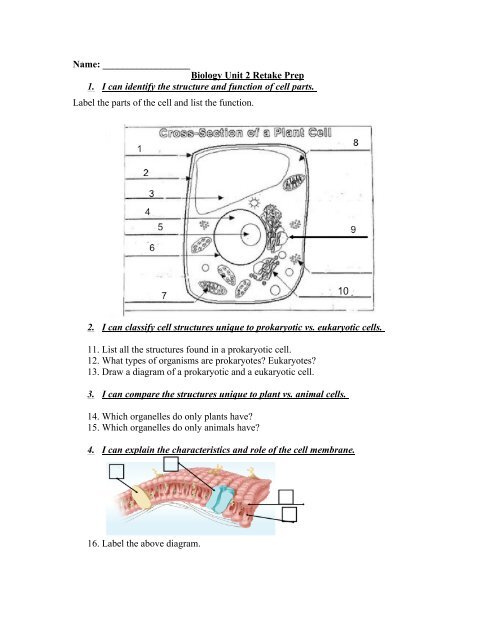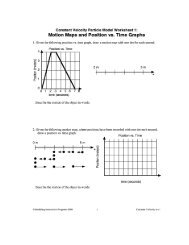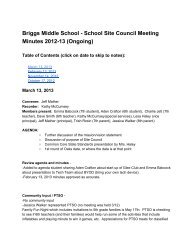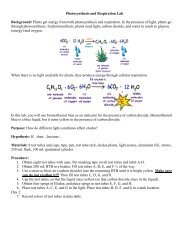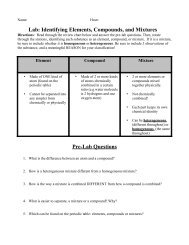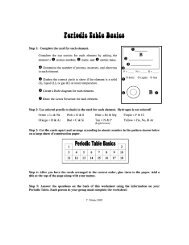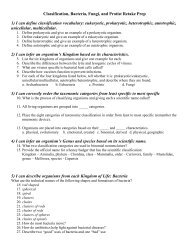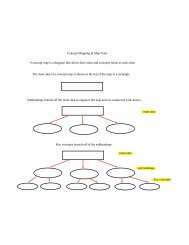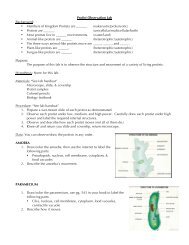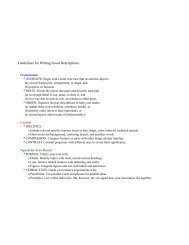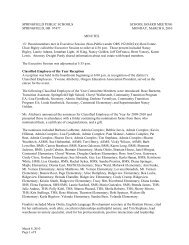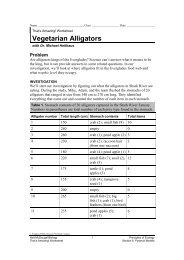Biology Unit 2 Retake Prep 1. I can identify the structure and function ...
Biology Unit 2 Retake Prep 1. I can identify the structure and function ...
Biology Unit 2 Retake Prep 1. I can identify the structure and function ...
Create successful ePaper yourself
Turn your PDF publications into a flip-book with our unique Google optimized e-Paper software.
Name: __________________<br />
<strong>Biology</strong> <strong>Unit</strong> 2 <strong>Retake</strong> <strong>Prep</strong><br />
<strong>1.</strong> I <strong>can</strong> <strong>identify</strong> <strong>the</strong> <strong>structure</strong> <strong>and</strong> <strong>function</strong> of cell parts.<br />
Label <strong>the</strong> parts of <strong>the</strong> cell <strong>and</strong> list <strong>the</strong> <strong>function</strong>.<br />
2. I <strong>can</strong> classify cell <strong>structure</strong>s unique to prokaryotic vs. eukaryotic cells.<br />
1<strong>1.</strong> List all <strong>the</strong> <strong>structure</strong>s found in a prokaryotic cell.<br />
12. What types of organisms are prokaryotes? Eukaryotes?<br />
13. Draw a diagram of a prokaryotic <strong>and</strong> a eukaryotic cell.<br />
3. I <strong>can</strong> compare <strong>the</strong> <strong>structure</strong>s unique to plant vs. animal cells.<br />
14. Which organelles do only plants have?<br />
15. Which organelles do only animals have?<br />
4. I <strong>can</strong> explain <strong>the</strong> characteristics <strong>and</strong> role of <strong>the</strong> cell membrane.<br />
16. Label <strong>the</strong> above diagram.
17-18. Label <strong>the</strong> below diagram.<br />
5. I <strong>can</strong> distinguish between active <strong>and</strong> passive transport.<br />
19. Define active transport.<br />
20. Define passive transport.<br />
2<strong>1.</strong> Define diffusion.<br />
22. What’s <strong>the</strong> difference between osmosis <strong>and</strong> diffusion?<br />
23. Draw a picture of exocytosis.<br />
24. Draw a picture of endocytosis.<br />
6. I <strong>can</strong> predict <strong>the</strong> movement of substances across <strong>the</strong> cell membrane.<br />
25. Define hypertonic, hypotonic, <strong>and</strong> isotonic.<br />
26. Describe <strong>the</strong> movement of water when a cell is placed in a hypertonic solution.<br />
27. Draw pictures of two potatoes placed in salt water <strong>and</strong> fresh water. Predict <strong>the</strong><br />
movement of water with an arrow <strong>and</strong> state if <strong>the</strong> potato will shrivel or swell.<br />
7. I <strong>can</strong> summarize how photosyn<strong>the</strong>sis <strong>and</strong> respiration are mechanisms for obtaining<br />
energy.<br />
28. Write <strong>the</strong> chemical equation for respiration.<br />
29. Write <strong>the</strong> chemical equation for photosyn<strong>the</strong>sis.<br />
30. What happens in glycolysis? What molecule is formed? Where does it take place?<br />
3<strong>1.</strong> How are <strong>the</strong> pathways for aerobic respiration different from anaerobic respiration?<br />
32. What are <strong>the</strong> final products of anaerobic respiration that is different from aerobic<br />
respiration?<br />
33. What are <strong>the</strong> products of <strong>the</strong> light independent reaction in photosyn<strong>the</strong>sis?<br />
34. What are <strong>the</strong> products of <strong>the</strong> light dependent reaction in photosyn<strong>the</strong>sis?<br />
35. Describe when plants undergo photosyn<strong>the</strong>sis <strong>and</strong> cellular respiration.<br />
8. I <strong>can</strong> describe <strong>the</strong> relationship between photosyn<strong>the</strong>sis <strong>and</strong> respiration in <strong>the</strong><br />
carbon cycle.<br />
36. Draw a picture of an aquarium with autotrophs <strong>and</strong> heterotrophs. Label <strong>the</strong> carbon<br />
cycle that is happening in <strong>the</strong> aquarium.<br />
37. If BTB is added to <strong>the</strong> aquarium, describe <strong>the</strong> color of <strong>the</strong> solution in <strong>the</strong> light <strong>and</strong> <strong>the</strong><br />
dark.


